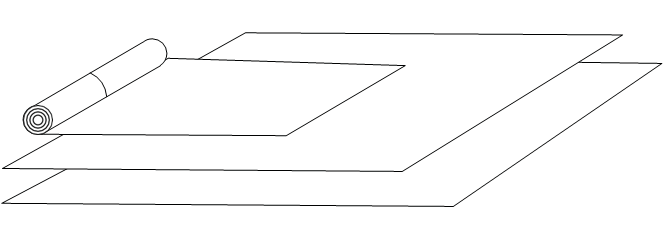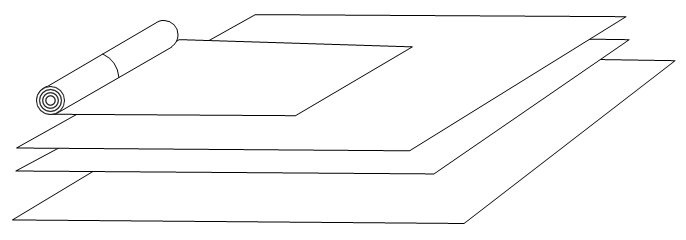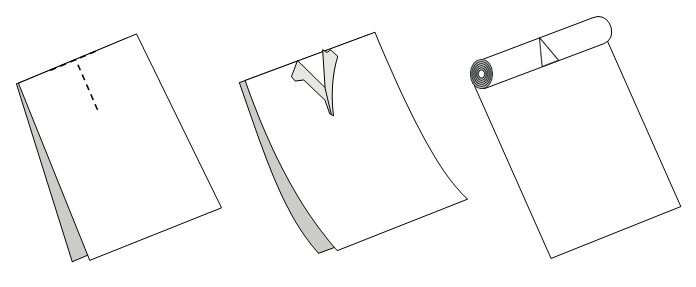Checklist for Washing & Shrouding the Deceased
(Appendix 3)

Checklist for shrouding
1. 5 pieces of clean sheets, preferably white material, cut into the required lengths (see below “Shrouding”).
2. Approximately 14 metres of material required.
3. 5 wraps for a woman.
4. 3 wraps for a man.
5. 3 thin strips of cotton for tying the shroud. One long enough to go round the middle of the body and two shorter ones to secure the ends of the shroud.
6. 2 pieces of thicker material of any dark colour to cover the body while washing - towelling material is recommended. Each sheet should be at least one metre squared.
7. 2 large clean towels for drying the body. These should preferably not be new, as towels that have been washed absorb moisture better.
8. 2 pairs of strong rubber gloves.
9. A box of disposable surgical gloves.
10. Cotton wool and Shampoo.
11. Soap and liquid soap in a dispenser.
12. Nail polish remover, if required.
13. 2 pairs of scissors and Masking tape.
14. Camphor and a non alcoholic form of perfume.
15. Bin bags for disposing of rubbish and for taking soiled material and towels to be washed.
16. Jug and a large bucket.
The Method of Washing
• It is recommended that at least four people be present to help bathe and carry the body (6 ladies in the case of a female death)
• Washing will normally take place at the undertaker’s premises, or at the Masjid where facilities are available.
• The Imam of the Masjid or experienced washing staff will usually be available to guide the washing and shrouding (Kafn) of the deceased.
• Only women should wash female bodies and men should wash male bodies. It is allowed for a wife to wash the body of her husband and vice versa. A woman may also wash the body of a young (minor) boy.
• A woman may not wash a dead body if she has menstrual bleeding or bleeding after the birth of a child, as washing the body is considered an act of worship. She may however, assist the washer without touching the body or observe for the benefit of learning.
• The dead body should be handled very gently. Hard rubbing must be avoided.
• The people who are performing the washing must be in the state of Wudhu.
• During Ghusl, it is permissible to place the body in one of the following two positions:
1. Having the legs facing the Qiblah
2. Having the right shoulder and side towards the Qiblah
• Everyone should be wearing rubber gloves or disposable gloves.
• The washer should utter his/her intention to wash the body mentioning the name of the person.
• All those assisting should help to lift the body carefully and gently onto the washing table. At the same time someone should hold the head and the feet.
• All present should keep reciting:

ALLĀHUM-MAGHFIR LAHŪ (FOR MALE)
O Allah forgive him or her.

ALLĀHUM-MAGHFIR LAHĀ (FOR FEMALE)
O Allah forgive her.
• One person should hold the head of the deceased firmly but gently from each side for the rest of the process. This is to avoid the possibility of breaking the neck (this job should be given to a relative who may not feel confident to assist in the washing).
• The washer should begin covering the body from the neck to the ankles with one of the thick sheets.
• Four people should hold the sheet slightly raised from the body, in order to allow the washer and his/her assistants to work unhampered.
• Intravenous drips, catheters etc. should be removed. If the tubes cannot be fully removed, then cut as near to the skin as possible. This is likely to cause bleeding, so place a small pad of cotton wool over the wound or tube and secure it with masking tape. Also remove any dentures.
• Remove any nail polish with cotton wool and nail polish remover.
• Cut away any hospital clothes and discard.
• Make sure all the equipment is ready and that the water in the shower is warm. If using a jug, mix the water to the correct temperature in
a large bucket.
• The person washing should then press the stomach of the deceased firmly but gently and clean the excreta with wet cotton wool.
• If the person died recently, the head and shoulders can be slightly raised while the stomach is pressed to assist the evacuation of any waste materials. However extreme caution should be taken, especially in the cases of death during childbirth or during an operation, as this can cause excessive bleeding from the mouth. If the body has been in cold storage, then there is no point in carrying out this procedure.
• The body should then be tilted to the left side and the area of the back passage should be similarly cleaned with flowing water.
• The washer should perform Wudhu (abultion) for the deceased, i.e. wash the hands and arms, three times starting with the right. Then wash the face 3 times, then wipe over the hair from the forehead backwards. Then finish by washing the right foot to the ankle and then the left foot to the ankle. The mouth and nose are washed three times, only if the deceased was in a state of ritual impurity that would have obliged them to make ghusl (ritual bath) before praying. (i.e. if the deceased was menstruating)
• This can be done with small pieces of wet cotton wool which are then discarded.
• At this point, it is a good idea to place thick pads of clean dry wool over the eyes, mouth, ears and nose. This is to prevent excess water running in during the main washing.
• Next, wash the hair with water and shampoo. According to the Sunnah, for females if the hair is braided it should be undone, washed and then parted into half and brought forward to the front. If a headrest is available this should be used during the washing of the hair. Otherwise two people can support the shoulders.
• It is advisable to wash the neck at the same time, this is to limit the number of times the body is moved.
• The washer should soap and wash the front of the body (excess movement should be avoided throughout the process).
• This should be done quickly without staring at any exposed part of the body. Always ensure that the water is flowing away from the body and is not accumulating underneath it at any point.
• The body should be tilted to the left to soap and wash the right side of the back, and then tilted to the right to soap and wash the left side of the back.
• While tilting the body, again check for any discharge of excretion, wash the area thoroughly with plenty of water if any is found.
• If there are any tubes or wounds that have been covered with cotton wool, remove the soiled cotton wool, wash the area quickly and tape a fresh pad over the wound.
• The whole body should then be rinsed with clear, warm water leaving no trace of impurities or soap.
• The body should be rinsed an odd number of times, the preference being given to three, five or seven according to the Sunnah. There is no harm if members of the family wish to help with the rinsing.
• The last rinse should be using camphor which may be dissolved in warm water in a bucket.
• The body should then be dried. One towel should be draped around the head in order to dry the hair. The second towel should be used to dry the body on the front sides. At the same time, the wet sheet should be removed and a clean, dry sheet should be placed over the body. All this should be done without exposing the private parts of the body. For example, two people should hold the wet sheet slightly raised from the body, the towel is then used to dry the body. As the towel is taken down the body, two more people follow with the rolled up dry sheet, gradually enfolding it as they go.
• The body is tilted to the left side and the towel is placed underneath and tucked as far under as possible. The body is then tilted to the right side and the towel drawn through. It is useful at this point for someone to quickly wipe the table with paper towels to take up the excess moisture (this only applies when the table is not equipped
with straps or rollers, which raise the body slightly from the surface).
• Finally, the body should be perfumed an odd number of times, preferably three according to the Sunnah. A non-alcoholic form of perfume should be used. Camphor can be put on the body.
• The table is then wheeled next to the coffin which should be on a table of similar height. The shroud should already be laid out in the correct order in the coffin as mentioned in the following sections.
• Then everyone present should help to lift the body gently and carefully as possible into the coffin. One person still remains holding the head and another should be at the feet. Then several people stand on the far side of the coffin to receive the body and several next to the table to lift the body. The body is carefully raised and passed over, and then lowered into the coffin.
• The towel underneath should be kept in place until the body is in the coffin. The body should be tilted to the side, rolling the towel up and then sliding it out.
• The body is then shrouded as described in the method for shrouding.
Taking a Shower after Bathing the Deceased
For a person who bathes the body of the deceased, it is desirable (Mustahab) that he/she themselves take a bath once this process is over according to a narration from the blessed Companion, Abu Hurayrah (ra) The Holy Prophet (saw) said:
“The person who bathes the deceased should himself take a bath”. [Ibn Majah]
Purchasing the Shroud
A shroud should be of good quality but not extravagantly expensive. It is not permitted for a man or woman to be buried in a silk shroud as this is extravagance. The shroud or its price should come from the wealth
of the deceased, even if that is the only wealth he or she has. If there is no money the responsibility then falls on the guardian, then the public treasury, and then the individual Muslims of the family in the order of closeness to the deceased.
NOTE: This is usually provided by the funeral service as part of the funeral costs.
Preferable Practices in Shrouding
The shroud should be pleasant, clean and large enough to cover the entire body. Twenty metres of material will be needed for the shroud as some wraps need to be doubled in width to make them wide enough for wrapping.
A shroud should be white, as this was the practice of our beloved Prophet (saw) and should be scented and perfumed. The shroud should be 3 wraps for a man and 5 wraps for a woman.
Woman’s Shroud
1. Material: Lifafah - Outer sheet (Length 2.4m by Width 1.5m)
2. Material: Sina’band (Chest wrap) (Length 2.1m by Width 1.5m)
3. Material: Izar / Loin Cloth (Length 2.1m by Width 1.5m)
4. Material: Qamis / Kurta or Shirt (Length 1.5m by Width 1.2/1.5m)
Fold in half and from the centre, make a T shaped cut for the neck front region without sleeves.
5. Material: Orhni / Scarf (Length 1.2m by Width 0.6m)
6. 3 x strips of cotton material for keeping the shroud in place
Men’s Shroud
(sizes same as above) It has a:
1. Lifafah outer sheet
2. Qamis / Shirt
3. Izar / loin cloth
NOTE: If a pilgrim dies, he is to be washed in the same way any non- pilgrim is washed, but he should be shrouded in his Ihram. His head should not be covered, nor should any perfume be applied to his body, because the restrictions of Ihram still apply to him.
HOW TO LAY THE DEAD IN THE KAFN (SHROUD)
The method of shrouding
1. Place three thin strips of cotton material for tying the shroud tape them outside the coffin to keep them in position. The stripes must be placed - one near the head, one in the middle and one near the feet.
2. Spread the Lifafah outer sheet in the coffin.
3. Spread the Sina’band / chest piece from the shoulder position.
4. Spread Izar from the feet and upwards.
5. Spread the back of the Qamis / shirt and roll up the front, keeping it near head end (From neck down to feet).
6. Leave the Orhni / scarf on one side which will be put on last.
Order of Male Kafn
1. Qamis
2. Izar
3. Lifafah

Order of Female Kafn
1. Orhni (not shown)
2. Qamis
3. Izar
4. Sina’band
5. Lifafah

How Qamis should be Cut and Folded

How the Kafn should be put on
1. Lower the body gently on to the Kafn / shroud. Cover the top part of the body up to the calves with the folded portion of Qamis.
2. Remove the sheet used for covering the body.
3. Rub camphor mixture on places of Sajdah: forehead, nose, both palms, knees and forefeet.
4. The hair should be divided into 2 parts and put onto the right and left shoulder over Qamis.
5. Cover the head and hair with Orhni/scarf. Do not fasten, but tuck in properly.
6. Fold the Izar the left flap first and then the right over the Qamis and scarf.
7. Now close the Sina’band (chest cover) in the same manner as above.
8. Close the Lifafah: the left flap first then the right.
9. Lastly fasten the ends of the Lifafah at the head-side, then the
feet and then around the middle with the strips of cloth. This is to keep the complete Kafn in place.
Prohibited Articles in the Kafn
1. It is prohibited to enclose any charter, verses of the Holy Qur’an or any Du`a in the Kafn.
2. It is forbidden to write the Shahadah, or any other Du`a on the Kafn or chest of the dead person.
What to do after the Kafn
With the completion of the washing and the Kafn, the deceased person is ready for the burial. The Janazah Salaah (funeral prayer) should be arranged without delay.
Rasulullah (saw) has said, “If a person passes away, hasten him to his grave and do not keep him away”. The Janazah Salaah must be arranged quickly and the deceased should be buried in the nearest Muslim graveyard (cemetery).
To transport the body over long distances is undesirable. It is also Makruh to delay the Janazah Salaah and wait for the late comers to increase the congregation.
IMPORTANT
It is ONLY permissible for the Mahram woman folk of the deceased male to see his face. They are his wife, mother, grandmothers, sisters, aunts, daughters and granddaughters. The Shariah does not allow any other woman to view the face of the deceased male. Similarly only the Mahram males should view the face of the deceased female.
In both cases of the male and female deceased, the face of the dead person should not be kept open after the Kafn is put on. The Quran may be recited next to the body before the Janazah is carried away.
